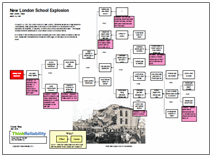Eight Marines were killed, and seven Marines and sailors were injured, as the result of the unexpected explosion of a 60 mm round inside a mortar tube during a live ammunition training exercise. While details are still to be determined, it is known that the unexpected explosion of a mortar round led to the deaths and injuries of those participating in a training exercise with a 60 mm round inside a mortar tube.
Though details of the incident are still unknown, we can begin a Cause Map, or visual root cause analysis, diagramming possible causes which remain to be investigated. As more information becomes available, evidence supporting or excluding potential causes is included on the Cause Map.
We capture the What, When and Where of the incident in the Problem Outline. In this case, a training accident/ explosion occurred on March 18, 2013 at about 10:00 pm at the Hawthorne Army Depot in western Nevada. At the time, a mountain training exercise with live ammunition was using a 60 mm round inside a mortar tube. A traffic accident that may be related has been mentioned in the news, but no detail has been provided. To ensure that this line of inquiry is followed during the investigation, we can include it in the “different, unusual, unique” line of the problem outline.
Data that is known, such as the types of damage resulting in deaths and injuries, is included with supporting evidence, in this case testimony of the hospital spokesman. Causes still to be determined, such as whether the mortar round exploded prematurely in the tube, detonated after being fired, or whether more than a single round exploded are included with question marks and joined by “OR”. When evidence is obtained throughout the investigation related to a given cause, it is included directly beneath the cause it controls. Along with the unknown method of detonation of the round, it is unknown whether an issue with the firing procedure, a malfunctioning firing device, or a malfunction in the explosive mortar is to blame.
More details should be coming soon since the use of 60 mm mortars is suspended until the review of this incident determines what happened. At that time, those causes ruled out by evidence can be crossed off (but left on the Cause Map so that others know they were considered and ruled out as more evidence became available).
At that time, solutions that best address the issues that were causally related can be brainstormed, evaluated, and implemented.
To view the Outline and Cause Map, please click “Download PDF” above. Or click here to read more.







